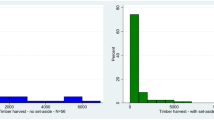Abstract
The effects of profit and land value tax on harvesting decisions of nonindustrial private forest owners are investigated. We use a model of a utility-maximizing forest owner with amenity preferences for timber, which extends the basic two-period harvesting model to include both thinning and clear-cutting harvests. It is demonstrated that with no amenity preference, the profit and land value taxes are neutral to clear-cutting and thinning decisions. Under small to medium amenity preferences, the profit tax decreases the optimal clear-cutting volumes. However, the effect on thinning may be positive or negative, depending on the amenity preference level. The total effect of the profit tax on the short-run timber supply is negative. The effects of the land value tax contrast with those of the profit tax. Also, a tax regime with a lowered profit tax rate combined with a land value tax is analysed. It is shown to be able to bring Pareto-improvement to a regime that uses a higher profit tax but no land value tax.


Similar content being viewed by others
Notes
Separability between consumption and amenity utilities is normally taken as a convention since there is no empirical evidence about the direction of cross-effect between these two utilities.
h can also be interpreted as the difference between the unit costs of thinning and clearcutting since the cost of clearcutting is assumed to be zero in this model.
Given the fact that the h actually decreases as the thinning volume increases, it would be realistic to assume a non-constant h. However, that would make our model more complicated without adding any new information to the purpose we are using the model for.
The substitution effect is the direct effect of an exogenous parameter, for example, a tax, and the income effect is an indirect effect that originates from a changed income level as a result of a change in an exogenous parameter.
If, for example, the length of one period is 10 years, a parameter value of 1 for interest rate would correspond to about a 7% annual interest rate.
It can be conjectured that the profit tax in forestry could also be nonneutral for other reasons, such as uncertainty in the timber price and the presence of inheritance.
One might argue that society may well prefer larger timber stocks than the privately optimal stocks implied by a neutral taxation, because society may put more value on the amenity or carbon stock properties of the private forests. However, if this is the case, the government could use specific policy instruments—instead of the profit tax—to alter the behaviour of the forest owners. These instruments would reflect the willingness-to-pay of the public for the amenity services of forests, and from the income distribution point of view they would lead to a socially more just situation than profit taxation, in which case the costs of providing amenity or climate services are laid on the forestry sector only, excluding the rest of society.
Since the timber price level is a crucial factor in determining the tax effects, we analyze the choice of tax regimes, using different price levels.
References
Chang SJ (1982) An economic analysis of forest taxation’s impact on optimal rotation age. Land Econ 58:310–323
Chang SJ (1983) Rotation age, management intensity and the economic factors of timber production: do changes in stumpage prices, interest rate, regeneration costs and forest taxation matter? For Sci 29:267–277
Klemperer WD (1976) Impacts of tax alternative on forest values and investment. Land Econ 52:135–157
Koskela E (1989a) Forest taxation and timber supply under price uncertainty: perfect capital markets. For Sci 35(1):137–159
Koskela E (1989b) Forest taxation and timber supply under price uncertainty: credit rationing in capital markets. For Sci 35(1):160–172
Koskela E, Ollikainen M (1997) Optimal design of forest taxation with multiple-use characteristics of forest stands. Environ Resour Econ 10:41–62
Koskela E, Ollikainen M (2001) Forest taxation and rotation age under private amenity valuation: new results. J Environ Econ Manag 42:374–384
Ollikainen M (1991) The effect of non-timber taxes on the harvest timing- the case of private non-industrial forest-owners: a note. For Sci 37(1):356–363
Ollikainen M (1993) A mena-variance approach to the short-term timber supply and forest taxation under multiple sources of uncertainty. Can J For Res 23:573–581
Ovaskainen V (1992) Forest Taxation; Timber Supply and Economic Efficiency. Acta Forestala Fennica 233. The Society of Forestry in Finland and the Finnish Forest Research Institute, Helsinki, p 88
Uusivuori J, Kuuluvainen J (2008) Forest taxation in multiple-stand forestry with amenity preferences. Can J For Res 38(4):806–820
Varian H (1992) Microeconomic Analysis, 3rd edn. W.W. Norton & Company, New York, London, p 506
Acknowledgments
This study has received funding from the Finnish Graduate School in Forest Sciences (GSForest), Helsinki University Centre for Environment HENVI, and Metsämiesten Säätiö Foundation, Finland. Authors thank two anonymous referees for useful comments and corrections. All the remaining errors are ours.
Conflict of interest
The authors declare that they have no conflict of interest.
Author information
Authors and Affiliations
Corresponding author
Additional information
Communicated by M. Moog.
An erratum to this article can be found at http://dx.doi.org/10.1007/s10342-009-0338-7
Rights and permissions
About this article
Cite this article
Barua, S.K., Kuuluvainen, J., Laturi, J. et al. Effects of forest taxation and amenity preferences on nonindustrial private forest owners. Eur J Forest Res 129, 163–172 (2010). https://doi.org/10.1007/s10342-009-0310-6
Received:
Revised:
Accepted:
Published:
Issue Date:
DOI: https://doi.org/10.1007/s10342-009-0310-6




